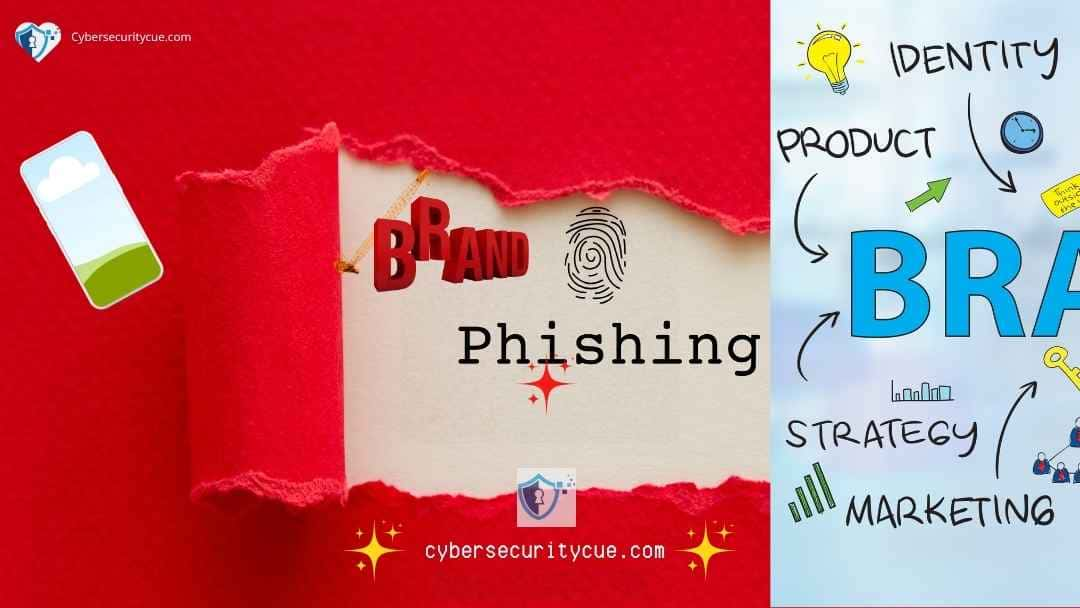Table of Contents
There’s a growing threat in the digital landscape known as brand impersonation phishing, where scammers imitate trusted companies to steal your personal information.
These fraudulent schemes can easily trap unsuspecting individuals and businesses alike, often leading to identity theft and financial loss.
Let’s learn how to identify these scams (brand impersonation phishing), the tactics employed by cybercriminals, and practical steps you can take to safeguard your information and protect your assets from these deceptive practices.
Key Takeaways to Brand Impersonation Phishing:
- Be vigilant in identifying signs of brand impersonation phishing, such as unusual email addresses or discrepancies in company logos and language.
- Implement multi-factor authentication and employee training to minimize the risk of falling for phishing scams.
- Verify communication through official channels before responding to requests for sensitive information from seemingly reputable sources.
The Intricacies of Brand Impersonation Phishing Tactics
Brand impersonation phishing tactics are sophisticated and ever-evolving, tailored to exploit your trust in reputable companies. Scammers meticulously mimic brand visuals, tone, and messaging to create a sense of authenticity.
They often use domain names that closely resemble legitimate ones, embedding subtle variations that can easily go unnoticed.
By leveraging current events or seasonal trends, they craft compelling narratives that prompt you to click, ensuring their brand impersonation phishing attempts appear timely and relevant.
Common Phishing Techniques Used by Scammers
Phishing scams often involve emails, texts, or direct messages that seem to come from trusted sources, such as financial institutions or popular retailers.
Scammers may use fraudulent links that lead to counterfeit websites designed to harvest your login credentials or sensitive information.
Spoofed sender addresses and urgent calls to action, such as account verification requests, entice you to react impulsively, lowering your guard against potential threats.
Social Engineering: The Psychology Behind Deception
Scammers frequently capitalize on psychological tricks to manipulate your emotions, ultimately leading you into their trap. By creating a sense of urgency or fear, they push you to act quickly without pausing to scrutinize the legitimacy of their claims.
This approach exploits inherent trust in authority figures or established brands, making you more susceptible to their tactics.
Social engineering encompasses various techniques designed to exploit human psychology, often preying on emotions like curiosity, fear, or urgency.
For example, a scammer might send you an email stating that your account has been compromised and action is needed within 24 hours to prevent suspension.
This tactic capitalizes on fear, prompting quick responses without thorough consideration.
Furthermore, using brand authority, like incorporating popular logos or mimicked email formats, adds legitimacy to their request, further enhancing the likelihood of compliance.
Understanding these psychological triggers enables you to remain vigilant and question the authenticity of incoming communications.
Unmasking the Signs of Phishing Emails
Phishing emails often exhibit telltale signs that can help you identify them before it’s too late. Look for suspicious sender addresses, poor grammar, and requests for sensitive information.
Phishing attempts may impersonate familiar companies or contacts, but often contain inconsistencies that reveal their malicious intent.
When confused about an email’s authenticity, taking a moment to scrutinize it can save you from falling victim to these deceitful tactics.
Distinguishing Legitimate Communication from Fakes
To differentiate between authentic and fraudulent messages, you should closely examine the sender’s email address.
Phishers frequently use email domains that resemble, but do not exactly match, legitimate company addresses.
Additionally, genuine emails often come from consistent sources, while phishing messages may originate from free email services or include unusual variations in spelling. Trust your instincts; if something feels off, investigate further.
The Role of Language and Design in Identifying Scams
Phishing emails frequently utilize poor language choices and unprofessional designs as telltale signs of their fraudulent nature.
Generic greetings, spelling errors, or awkward phrasing can be strong indicators of a scam.
Legitimate organizations typically adhere to brand guidelines, ensuring that their communication is polished and aligned with their visual identity.
In contrast, phishing attempts may have mismatched logos, inconsistent color palettes, or low-quality images.
Authentic corporate emails maintain a certain tone and structure, reflecting their brand identity and professional standards.
For instance, a tech company’s communication may incorporate industry-specific terms and a modern design layout, while phishing emails often lack this finesse.
Research shows that about 30% of phishing emails contain spelling or grammatical errors, making these key aspects invaluable in spotting scams.
By closely analyzing the language and design elements of emails, you can sharpen your ability to distinguish between legitimate messages and phony scams.
Building a Fortress: Strategies for Organizational Protection
Protecting your organization from brand impersonation phishing demands a multifaceted approach.
Building a robust security framework not only reinforces your defenses but also instills confidence among customers and employees.
Regular evaluations of your security measures, combined with proactive strategies, can create an effective barrier against attacks while ensuring that your organization stays resilient against evolving threats.
Employee Training and Cyber Awareness Programs
Poor awareness among employees significantly contributes to successful brand impersonation phishing attempts. Implementing comprehensive training programs equips your team with the skills to recognize phishing attempts and other cyber threats.
Regular workshops, practical simulations, and ongoing discussions about security best practices can cultivate a vigilant workforce that actively participates in safeguarding your organization.
Implementing Advanced Security Protocols and Software
Integrating advanced security measures is crucial in defending against brand impersonation phishing attacks.
Employing multi-factor authentication (MFA), firewalls, and continuous monitoring software helps detect and neutralize threats effectively.
Such technological investments not only protect sensitive data but also enhance your organization’s overall cyber hygiene, ensuring you stay one step ahead of potential impersonators.
- Employ multi-factor authentication for all sensitive accounts.
- Utilize AI-driven detection tools to identify unusual activities.
- Regularly update and patch software systems to close security gaps.
- Create a robust data encryption policy for sensitive information.
Key Security Measures
| Multi-Factor Authentication | Ensures that access is granted only after multiple verification methods are satisfied. |
| AI-Driven Detection | Analyzes patterns in user behavior to identify and alert for potential phishing threats. |
| Regular Software Updates | Addresses vulnerabilities in software, preventing easy exploitation by attackers. |
| Data Encryption | Keeps sensitive information secure, making it unreadable without the appropriate decryption tools. |
Advanced security protocols go beyond basic protections; they create a layered defense that significantly lowers your risk of falling victim to phishing scams.
For instance, regularly updating software decreases the likelihood of exploitative vulnerabilities and reinforces your cybersecurity measures.
Investing in monitored firewalls and endpoint detection systems additionally ensures that any suspicious activity is quickly analyzed, allowing for timely intervention.
By prioritizing these technologies, you bolster your organization’s defenses against an ever-present threat landscape.
- Implement security information and event management (SIEM) solutions to monitor activities in real time.
- Conduct penetration testing to simulate phishing attempts and uncover vulnerabilities.
- Integrate threat intelligence platforms to stay updated on emerging threats.
- Establish incident response plans for rapid action in the event of a breach.
Advanced Security Enhancements
| SIEM Solutions | Centralized logging and analysis of security events allows for swift detection and response to incidents. |
| Penetration Testing | Simulates attacks to assess the effectiveness of your current security measures and identify weaknesses. |
| Threat Intelligence Platforms | Collects data on current and emerging threats, helping you stay prepared against new phishing tactics. |
| Incident Response Plans | Pre-defined strategies for managing and mitigating breaches enhance your organization’s resilience. |
Navigating Legal Implications and Reporting Channels
Understanding the legal landscape surrounding brand impersonation phishing can help you protect your interests.
Reporting channels play a pivotal role in addressing fraudulent activities while also informing consumers and businesses about ongoing scams.
If you encounter instances of Brand Impersonation Phishing: A Danger to Business Reputation, knowing how to report them is vital to mitigate damage and uphold integrity within the business community.
Understanding Your Rights: Consumer Protections Against Fraud
As a consumer, various federal and state laws provide protections against fraud, including deceptive business practices and identity theft.
Awareness of these laws allows you to take action if a company misrepresents itself to you.
Reporting fraudulent activities can also lead to investigations and potential legal consequences for scammers, ultimately working to safeguard others from similar experiences.
The Importance of Reporting Phishing Attempts
Reporting phishing attempts not only aids in your protection but also contributes to broader efforts in combating fraud.
By submitting reports to proper authorities such as the Federal Trade Commission (FTC) or your local consumer protection agency, you help build a database of fraudulent tactics.
This information can be instrumental in identifying trends, evolving scams, and enhancing overall consumer awareness and security.
Your actions in reporting these incidents might feel inconsequential, but collectively, they foster a safer online environment. Each report raises awareness among law enforcement and tech companies that can develop more robust security measures.
Moreover, reporting helps these organizations track down persistent offenders, who might otherwise continue to exploit vulnerabilities in the digital marketplace.
When more individuals take proactive steps to report scams, it sends a message to fraudsters: accountability is coming, and their activities will not go unchecked.
The Future of Brand Protection: Trends to Watch
Brand protection continues to evolve alongside the tactics employed by cybercriminals. As digital landscapes change, organizations must stay ahead of emerging threats while enhancing their defensive measures.
This includes leveraging artificial intelligence for real-time threat detection and investing in employee training programs that address the latest phishing techniques.
It’s vital to remain informed about trends in cybersecurity and adapt strategies accordingly to safeguard your brand’s reputation and customer trust.
Emerging Technologies in Cybersecurity
Artificial intelligence and machine learning are shaping the future of cybersecurity significantly. By analyzing large datasets, these technologies can identify and respond to unusual patterns indicative of phishing attempts more swiftly than traditional methods.
Automated systems can also streamline incident responses, enabling your team to act decisively against possible threats before they escalate.
Anticipating Evolving Phishing Techniques
Staying ahead of phishing threats means understanding that these scams will adapt as swiftly as the defenses put in place.
Phishers are increasingly using sophisticated techniques such as deepfake technology and targeted social engineering, which can make fraudulent communications appear more legitimate.
For instance, they might replicate your company’s branding with startling accuracy or employ personalized tactics based on harvested data from social media platforms.
As the tactics employed by scammers become more nuanced, it’s vital to anticipate these changes by conducting regular penetration testing and simulations within your organization.
Education surrounding the psychological tactics used in phishing will prepare your staff to recognize and combat these evolving threats effectively.
For instance, knowing that attackers may impersonate executives or trusted partners can make employees more vigilant when responding to unexpected communications.
Further, employing advanced filtering technologies that learn from previous successful attacks can enhance your proactive measures, keeping your brand safe from impersonation attempts.
Conclusion
From above, it is evident that brand impersonation phishing presents significant risks to your personal and financial security.
To protect yourself against these fake company scams, stay alert to the signs of phishing attempts, verify communications from companies, and utilize security measures such as two-factor authentication.
By remaining informed and vigilant, you can strengthen your defenses and ensure that your sensitive information stays safe from cybercriminals.
FAQ
What is brand impersonation phishing?
Brand impersonation phishing is a tactic used by cybercriminals to deceive individuals by masquerading as a legitimate brand or company. This often involves creating fake websites, emails, or social media profiles that closely resemble those of recognized companies. The goal is to trick users into providing sensitive information, such as login credentials or financial details, thinking they are interacting with a trusted entity.
How can I identify a phishing attempt that impersonates a brand?
Several signs can help you identify a phishing attempt. Look for inconsistencies in email addresses or URLs, as legitimate companies typically have official domains. Additionally, watch for poor grammar, spelling mistakes, and urgent language requesting immediate action. If you receive unsolicited communications asking for personal information, verify with the company through official channels before responding.
What steps can I take to protect myself from brand impersonation phishing scams?
To protect yourself, always approach unexpected communications with caution. Verify the authenticity of emails or messages by contacting the company directly using known contact information. Utilize multi-factor authentication (MFA) wherever possible to add an extra layer of security to your accounts. Additionally, keep your software and security solutions updated to help guard against malware and phishing attempts.
What should I do if I believe I have fallen victim to a brand impersonation phishing scam?
If you suspect that you have been a victim of a phishing scam, act quickly. Change any compromised passwords immediately and enable multi-factor authentication on your accounts. Monitor your financial statements for unusual activity and report any unauthorized transactions to your bank or credit card provider. Additionally, consider reporting the phishing attempt to the legitimate company being impersonated and to local authorities or consumer protection agencies.
Can companies protect themselves from being impersonated in phishing scams?
Yes, companies can take several measures to reduce the risk of brand impersonation phishing. Implementing domain monitoring can help identify unauthorized use of their brand online. Educating employees about phishing tactics can enhance internal security. Furthermore, employing anti-phishing technologies and techniques, such as DMARC (Domain-based Message Authentication, Reporting & Conformance), can assist in protecting email communications and reducing the lifespan of phishing attempts masquerading as their brand.





